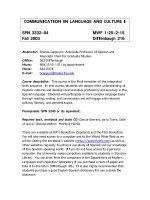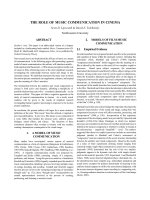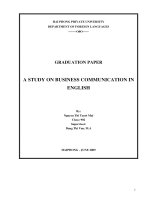communication in negotiation
Bạn đang xem bản rút gọn của tài liệu. Xem và tải ngay bản đầy đủ của tài liệu tại đây (344.79 KB, 22 trang )
Session 5
Communication in Negotiation
Communication in Negotiation
Communication processes, both verbal
and nonverbal, are critical to
achieving negotiation goals and to
resolving conflicts.
•
Negotiation is a process of interaction
•
Negotiation is a context for
communication subtleties that
influence processes and outcomes
Basic Models of Communication
Communication is an activity that occurs between two
people: a sender and a receiver
•
A sender has a meaning in mind and encodes this
meaning into a message that is transmitted to a
receiver
•
A receiver provides information about how the
message was received and by becoming a sender
and responding to, building on, or rebutting the
original message (processes referred to as
“feedback”)
Distortion in Communication
1. Senders and receivers
–
The more diverse their goals or the more
antagonistic they are in their relationship, the
greater the likelihood that distortions and errors
in communication will occur
2. Transmitters and receptors
–
The choice of transmitter can affect outcomes
•
Some messages may be better spoken,
others written
•
Poor eyesight, faulty hearing, etc. diminish the
ability of a receiver to receive a message
accurately
Distortion in Communication
3. Messages
–
The symbolic forms by which information is
communicated
–
The more we use symbolic communication,
the more likely the symbols may not
accurately communicate the meaning we
intend
4. Encoding
–
The process by which messages are put into
symbolic form
–
Senders are likely to encode messages in a
form which receivers may not prefer
Distortion in Communication
5.Channels
–
The conduits by which messages are carried
from one party to another
–
Messages are subject to distortion from
channel noise or various forms of interference
6.Decoding
–
The process of translating messages from their
symbolic form into a form that makes sense
–
When people speak different languages,
decoding involves higher degrees of error
Distortion in Communication
7. Meanings
–
The facts, ideas, feelings, reactions, or thoughts
that exist within individuals and act as filters for
interpreting the decoded messages
–
Those filters can introduce distortions
8. Feedback
–
The process by which the receiver reacts to the
sender’s message
–
Absence of feedback can contribute to
significant distortions
–
Feedback can distort communication by
influencing the offers negotiators make
How to Improve
Communication in Negotiation
•
Use of questions: two basic categories
–
Manageable
•
Cause attention or prepare the other person’s
thinking for further questions:
–
“May I ask you a question?”
•
getting information
–
“How much will this cost?”
•
generating thoughts
–
“Do you have any suggestions for improving
this?”
How to Improve
Communication in Negotiation
•
Use of questions: two basic categories
–
Unmanageable questions
•
Cause difficulty
–
“Where did you get that dumb idea?”
•
give information
–
“Didn’t you know we couldn’t afford this?”
•
bring the discussion to a false conclusion
–
“Don’t you think we have talked about this
enough?”
How to Improve
Communication in Negotiation
•
Listening: three major forms
1. Passive listening: Receiving the message
while providing no feedback to the sender
2. Acknowledgment: Receivers nod their
heads, maintain eye contact, or interject
responses
3. Active listening: Receivers restate or
paraphrase the sender’s message in their
own language
How to Improve
Communication in Negotiation
•
Role reversal
–
Negotiators understand the other party’s positions
by actively arguing these positions until the other
party is convinced that he or she is understood
–
Impact and success of the role-reversal technique
1. Effective in producing cognitive changes and
attitude changes
2. When the positions are compatible, likely to
produce acceptable results; when the positions
are incompatible, may inhibit positive change
3. Not necessarily effective overall as a means of
inducing agreement between parties
12
WHAT YOU HEAR
WORDS
WHAT YOU SEE OR FEEL
•
Tone of voice
•
Vocal Clarity
•
Verbal expressiveness
•
Facial expression
•
Dress & grooming
•
Posture/ Guesture/ touches
•
Eye contacts
13
would you
like something
to drink?
Filter
Filter
1
2
3
4
5
6
14
Physical Barriers
Sounds, poor eye sight, tiredness, stress,
weather
Emotions
Hate, fear, love, anger, lack of feeling
Assumptions and Perceptions
Lack of clarity, lack of feedback
Individual differences
Sex, age, confidence level, past experiences,
education level, race, culture, beliefs, attitudes
Communicaon Barriers
15
Languages
Dialects, tone, meanings, written
Cultural styles
Direct/ Indirect, rules of politeness,
formality/informality
Non-Verbal Cues
non-verbal cues are inconsistent with oral
message => confusion
Communicaon Barriers
16
Acve Listening
Listening with a purpose
•
Only hearing sound?
•
Creang meaning?
17
Acve listening happens when:
•
The listener hears
the messages
•
Understands their
meaning
•
Veri(es the meaning
by o*ering feedback
Veri(es feedback
Understands meaning
Hears the messages
18
Active Listening
•
Ask open ended questions
•
Reflects feelings
–
Attempts to understand how the other
person feels in response to his/her
circumstances
–
Shows empathy
–
Defuses emotion
–
Creates a feeling of acceptance
19
Active Listening
•
Listen like a student. Assume
there are things about the
situation that you don't
understand. And even in areas
you are confident you do
understand, listen for data that
undermines rather than
supports your beliefs, under
the assumption that you could
be wrong or only partially right.
•
Find your own style of
listening. If you are sincere
about understanding what
someone is saying and feeling,
your concern will come across
and you won't sound
mechanical.
•
Listen for the real meaning
of criticism. It's easy to
listen and reply to
compliments.
•
Focusing on other opinions
can also give the listener the
chance to reflect on the
process and strategy.
Stepping aside and taking a
dispassionate view of the
goings-on can make one a
far more effective negotiator.
20
Confirms key points by summarizing
–
Restate the result of the conversation in a clear
concise manner
–
Summarize key points made or agreements
reached
–
Close the conversation with a summary
–
Provides opportunity to correct any
misunderstanding
–
Shows courtesy
–
Saves time
–
Acknowledges speaker
21
Rapport
•
Mutual gains negotiation requires rapport.
–
You're trying to convince your counterpart that your offer
is fair; you designed it to meet his interests as well as
yours.
–
How much success will you have if your counterpart has
zero faith in your ability to understand his interests?
–
Successful negotiation starts with building shared
understanding of the situation.
•
Words of understanding
–
We usually set out to build understanding with words.
–
When we find that we're not understood, we say, "Let me
clarify " And then we try saying the same thing a
different way.
22
Rapport
•
Step into each person’s world.
•
See it from their perspective.
•
Think their style, talk their style,
become their style.









